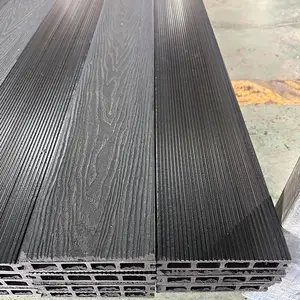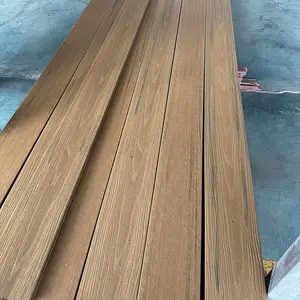(50786 products available)































































































































































































































































Plastic composite, WPC decking flooring, is available in various types and structures to suit different needs and preferences. Each type provides aesthetic and functional benefits, from solid to hollow and textured to non-textured. Common types of WPC decking include the following:
Solid WPC decking
Compared to other types, solid WPC decking is thicker and heavier. Such decking has better durability and strength; hence, it is ideal for commercial and residential areas with heavy foot traffic. Their thickness helps provide stability, and solid WPC decking can also help the area in which it is installed to look more elegant and contemporary.
Hollow WPC decking
Unlike solid WPC decking, hollow WPC decking has a lightweight construction. It consists of an empty core or a hollow core design that conserves materials without considerably sacrificing the decking's strength. Hollow WPC is perfect for DIY installation and moderate foot traffic as it is easier to handle and install. However, such a type might not be suitable for heavy furniture or equipment, as it might sag in some places.
Textured WPC decking
Textured WPC decking has surfaces that give it a natural wood feel. These surfaces are ridged to enhance grip and minimize slippage. Textured decking is ideal for pool areas, patios, and outdoor walkways. This is because it offers both comfort and security and beautifies the space with its rich, natural-like appearance.
Engineered WPC boards
Engineered WPC boards are made of a wood-plastic composite core and topped with a layer of PVC or similar materials for a wear-resistant surface. This kind of decking is designed to be waterproof and scratchproof, making it ideal for harsh settings, both indoors and outdoors. They are also available in laminate finishes that make them look like real wood, but they are thinner and easier to install.
Anti-slip WPC decking
WPC decking adds safety features to wet and dry areas that demand good traction. This is important when installing the decking in pool areas, outdoor kitchens, or patios. Anti-slip WPC decking helps reduce accidents and still looks good while offering functionality that suits different climates and settings.
The main features of wood-plastic composite (WPC) decking are impermeability and low maintenance. These materials provide a suitable alternative to wood in areas with high water levels or humidity, such as poolside, gardens, terraces, and porches. Also, its low care needs are a huge benefit to the users.
Water resistance and pooling
WPC decking is significantly waterproof, as most of its materials are composite plastic and wood, which make them efficient in resisting water than natural wood. Certain WPC brands treat their boards with added waterproofing to withstand water ingress or pooling. In addition, the closed cellular structure of hollow WPC boards enhances their waterproof property by reducing water absorption. This feature helps minimize problems such as warping, cracking, and mold growth, often common with natural wood under wet conditions.
Low maintenance characteristics
One of the principal advantages of WPC decking is that it needs little to no maintenance. Natural wood must be painted, stained, oiled, or replaced after some time, but WPC decking requires only periodic cleaning to remove debris, dirt, and stains. Some water-resistant WPC decks come with surface coatings, making them even easier to clean and maintain. In contrast to natural wooden decks that fade, chip, or crack, WPC decks may also include UV protection against fading and wear. These low-maintenance and water-resistant features make WPC decking a cost-effective long-term solution for residential and commercial clients.
There are many design considerations for wood-plastic composite (WPC) decking. They vary depending on the desired look, interior decor, functionality, and the budget of the user. Below are some inspirational ideas when selecting WPC decking for an outdoor or indoor space:
Natural wood appearance
One of the important factors a buyer considers when selecting WPC decking is the type and shade of natural wood it resembles. WPC can be found in shades ranging from deep walnut and mahogany to light ash and cedar. Some also have a grained surface that adds to their resemblance to real wood.
Contrast with surroundings
Working with the existing landscape or architectural elements of the building may require choosing a composite deck that effectively contrasts with the walls and floors of the building and existing outdoor features like fences, pergolas, and landscaping. Lighter shades like coastal grey or beach sand reflect light and create a striking visual in views of outdoor gardens and greenery. On the other hand, darker tones like charcoal or graphite provide a very sleek and elegant contemporary feel.
Different WPC decking layouts
Using WPC in different layouts adds stylish and functional accents to areas. Typical arrangements are oriented boards that lay parallel to the house in a traditional form, herringbone, chevron, and diagonal patterns that add unique flair to the space. For multi-level decks or complex outdoor areas, inlay WPC strips can add extra interest. A combination of two or more shades of composite materials is called deck delineation and defines areas of the deck with various uses; hence, it adds beauty and practicality as well.
Rims and railing ideas
The edges of the deck and the railing are very important as they round out the style of the composite deck. WPC skirting can be simplistic and elegant flush trims or more complex fascia-level tiers. There are many railing choices, from understated slats and glass panels to sophisticated metal and cable designs. The railing material can be like the decking or a different one to increase the deck's overall beauty. Accents like LED lighting, stainless steel cables, and mounted planters improve the railing section's functionality and style.
Textured finishes and accessories
WPC decking comes with a textured finish that makes the surface slip-proof and enhances its relationship with nature. Matte and brushed finishes, for instance, add to the natural-like feel with an anti-slip function, making the surface safer to walk on when wet. Regarding accessories, there are many choices: built-in benches, pergolas and shades, under-deck ceilings and lighting, and kicker strips and risers in classrooms. These enhancements raise the comfort and usefulness of the space, turning the WPC deck into a cozy outdoor living room that is pleasant year-round.
When selecting the most suitable plastic composite WPC decking for customers or a business, buyers will need to apply some key criteria to help them make the right choice. These features determine what material should go where, how it should look, and how long it should last.
Type of deck
The first thing to do is establish what the decking will be used for and where it will be used. Solid WPC decking is most suitable for high-traffic areas such as commercial patios and walkways or residential pool decks and gardens. If the composite material is to be used in areas with light foot traffic, buyers have options: hollow WPC decking is lightweight and easy to install. Engineered WPC is slim and designed for heavy usage inside and outside, while textured WPC has a non-slip surface, making it ideal for areas that require more safety features.
Impression and maintenance
Most of today's WPC decking manufacturers have produced materials with different shades and textures that resemble natural wood. Some of these materials' plastic are treated with UV stabilizers that prevent them from fading when exposed to sun rays. Buyers should educate customers about the other models that require little maintenance apart from simple cleaning. Such materials will have dirt and stain-resistant properties, which are good for outdoor decorations.
Decking size and thickness
All things considered, buyers should settle for materials that fit the requirements of their intended use. Some WPC deck boards come in standard widths. Thickness, on the other hand, may vary depending on how the composite will be used. Thicker boards will be more solid and heavy, making them appropriate for high-traffic areas. Customers who want to do the installation themselves will appreciate lighter boards.
Compatibility with other materials
In a composite deck setup, several elements must coordinate with each other in terms of design and function. Buyers should look for compatible fastening systems and hidden clips. These two are crucial to the overall beauty of the deck since they can hold the deck in place without conspicuously showing screws on the surface. Composite decking should be compatible with extruded aluminum, wood, or composite joists. Customers may want to add some accessories like railings, skirting, and lighting, so buyers should request the companion products of the decking brands they stock.
Budget and warranty
Cost is a deciding factor that buyers should consider when selecting WPC decking materials. In most cases, the quality of the composite determines the overall cost. Ask about the warranty of the product. Generally, limited lifetime warranties are for fading, stains, splitting, and other manufacturers' defects. In specific situations, WPC deck boards may be returned without additional charges.
A1: WP decking, which is plastic composite, is appropriate for residential and commercial environments because of its durability and low maintenance. This makes it ideal for outdoor areas such as terraces, gardens, pool decks, and walkways, where it's required for people to have stylish and hard-wearing surfaces. Also good within hotels, restaurants, and resorts, where large areas are installed and an elegant, contemporary look sought after.
A2: There are ways to increase the longevity of WPC decking outdoors. Select a brand with built-in UV stabilization. This helps prevent the plastic from degrading and the colors from fading. Also, put a protective sealant made specifically for composites onto the deck surface. This will help repel water, dirt, and other debris. Regular cleaning of the deck using a soft-bristled brush and mild detergent will increase its attractiveness and durability.
A3: Yes, WPC is recyclable but only a little of it gets recycled today. Things are looking up for composite materials, though, because the manufacturers are coming up with take-back programs and partnerships with recyclers. They could offer or encourage customers to return old materials to be converted into new products, such as flower pots and park benches. There are emerging technologies that will enable more of this material to be collected and used again, which will lower the environmental impact of making a new composite.
A4: Selects that are most likely to withstand the local climate conditions will appeal to buyers, such as moisture and temperature changes. They should also consider the warranty offered by various manufacturers as a proxy for material quality. Focus on sustainable brands and those using recycled content to promote the environmental aspect. Buyers should also look for corrosion-resistant fasteners and uncommon sizes to suit customers with unique projects.
A5: WPC decking surface options include textured, brushed, smooth, and matte finishes. A realistic wood-like feel is achieved and made slip-resistant using a textured or brushed finish. A sophisticated, understated look can be achieved using a matte finish. A smooth finish only looks elegant but also easy to clean.